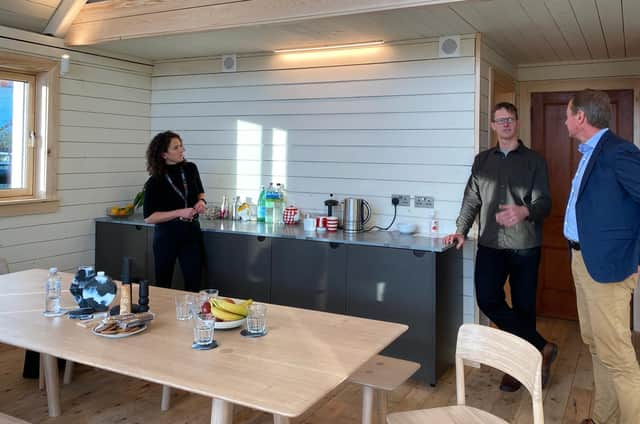Zero carbon house shows it's time for timber - Stuart Goodall


Sometimes, just one visual example brings all those verbal or written arguments to life - and this was it. As I listened to architect Peter Smith talking about the multiple benefits of this energy-efficient house made from Scottish wood, I was reminded how often I’ve responded to those who claim that Scottish wood isn’t good enough for building homes – and that we should forget growing wood here and import more from overseas.
Walking round the house, it looked and felt like a home, and while a Glasgow storm raged outside, it was quiet and serene inside …and warm. The five of us in the house created enough heat to raise the ambient temperature of this super-insulated, modern home.
Advertisement
Hide AdAdvertisement
Hide AdBuilt from Scottish-grown spruce, it is designed to store more carbon than is produced during construction. And it is a real home, not just a temporary showcase to impress COP26 delegates. It will be dismantled into panels and taken to the Highlands to be rebuilt as part of a sustainable housing development.


Mairi Gougeon, Scotland’s Cabinet Secretary for Rural Economy and Islands, visited the house with me, describing it as “an inspiring example of Scottish innovation in response to the climate emergency”. Patrick Harvie, Minister for Zero Carbon Buildings, also dropped by.
Politicians, and everyone else who saw the house, were hugely impressed by Peter Smith’s ability to articulate that creating 21st century homes must be about sustainability – and much more.
He said: “With the COP26 house, I wanted to demonstrate that truly sustainable, ecologically responsible buildings can also be beautiful, comfortable to live in and low cost to build using natural materials.
“As an industry we have a responsibility – and opportunity – to lead by example, to show the world how we can build sustainably by using timber. We also need to plant more trees in the UK and use what we already have as effectively as possible.”
This link between tree planting and wood use is fundamental. We need to increase both dramatically to meet our climate change ambitions.
Scotland is well ahead of the curve, with 80 per cent of the UK’s new tree planting happening here. It’s also the only part of the UK to commit to firm targets for using more wood in construction.
We are hearing positive noises from Westminster and hope ministers will commit to using more wood, in line with the Time for Timber manifesto, also launched at COP26. This would signal that the major forestry announcement at COP26 (the Glasgow Leaders Declaration on Forestry and Land Use) could have real impact.
Advertisement
Hide AdAdvertisement
Hide AdThe Declaration was a welcome recognition of the enormous significance of growing trees and using more sustainably-produced wood products in the fight against climate change.
However, responsibility for protecting global forests must not be limited to grand declarations at high-profile summits. The UK imports 80 per cent of the wood it uses and while global timber demand will continue soaring, the UK is forecast to have less home-grown wood available in the decade leading up to net zero D-day in 2050 (2045 in Scotland) than now.
To prevent increased pressure on fragile global forests, we must plant more sustainable, well-managed, mixed-species forests in the UK - and deliver more wood. This will help to decarbonise house-building and construction by displacing energy-intensive materials like brick and concrete.
As someone said, we don’t want ‘blah, blah, blah’. Instead, we need more well-designed, multi-purpose forests that people can walk through and enjoy, forests where we grow more of our own wood. If we do this, we can create more beautiful zero-carbon homes - and continue to tackle climate change at the same time.
Stuart Goodall is Chief Executive of Confor: promoting forestry and wood
Comments
Want to join the conversation? Please or to comment on this article.